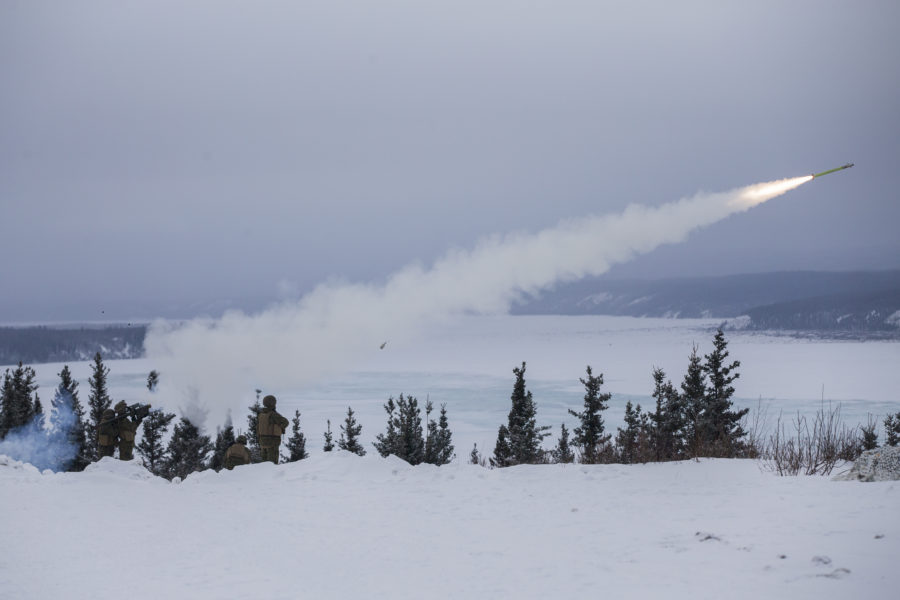With some 90,000 Russian troops massing on Ukraine’s eastern border and holding large-scale military exercises in the area, worries are growing that Russian President Vladimir Putin is preparing a possible invasion or other military actions against Ukraine. Ukrainian Minister of Defense Oleksii Reznikov visited Washington Nov. 18-19 seeking military assistance, but some fear a mismatch between the urgent situation and the slow pace of major international arms sales.
Russia’s joint exercises with Belarus included a presence northeast of Kyiv, which makes this situation different from prior mobilizations, including Russia’s 2014 invasion of southeastern Ukraine, said a senior Senate staffer, who asked not to be named. That southern region is still held by Russian-backed separatists, fueling a low-intensity conflict that persists in violation of the Minsk agreement that ended the invasion.
What’s different this time, the staffer said, is that in 2014, Putin “didn’t really use airpower because he was looking for some deniability.” This time, however, Putin has set up a different course of action. “If he goes this big, he’s not going to care about deniability,” the staffer said.
As winter approaches, the muddy fields, lakes, and rivers of Eastern Ukraine are freezing over, so mechanized vehicles and close air support left at the border after Russia’s exercises will have an easier route to travel.
To counter that, Ukraine will need counter-air, counter-artillery, and anti-tank weapons, said the staffer, who met with Reznikov during his recent visit to Washington.
“We did have a discussion about the counter-air,” the staffer said, but the minister seemed to be after “the Patriot-size stuff,” while short-term needs might be greater. “I would be worried about the next two months and getting everything we can that can make a difference,” the staffer said.
Getting approval to sell a complex air defense system such as the Patriot will take too long, he said, when the U.S. or NATO partners can offer man-portable air-defense systems such as the Stinger, which is still effective against slower-moving aircraft.
Marine Corps Lt. Col. Anton T. Semelroth, a Pentagon spokesperson, said in a written statement that U.S. assistance to Ukraine is ongoing. Investment reached $400 million this year and a total $2.5 billion since 2014. Another $300 million is anticipated in the 2022 National Defense Authorization bill, which is expected to clear the senate in early December.
“The United States has previously announced security assistance support in these domains,” Semelroth wrote, citing “air surveillance radars, counter-artillery radars, counter-unmanned aerial systems, and armed patrol boats.”
Asked by Air Force Magazine what systems he is seeking from the U.S., Reznikov said only that he sought air and naval defenses.
The Threat from Belarus
Close relations between Putin and Belarusian strongman Vicktor Lukashenko gives Russia a useful partner in the neighborhood. Belarus’ open invitation to Middle Eastern migrants to travel through it on tourist visas fueled a migrant a crisis earlier this month on the border with Poland involving tens of thousands of Polish and Lithuanian troops.
Wojciech Lorenz, defense analyst for the Polish Institute of International Affairs, said this was a new type of hybrid warfare and should be seen as a warning to Europe that it should cease assisting Ukraine.
Lorenz said Belarusian forces provoked Europeans on the border, using lasers to temporarily blind security patrols, firing stun grenades, and shooting blanks into the air. The psychological campaign seems designed to provoke a response which could then be used by Russia to suggest that NATO is planning to invade Belarus.
“We have seen major escalation,” Lorenz said in a phone interview from Warsaw. “By increasing the credibility of escalation against Poland, the Baltic States, and NATO through Belarus, they wanted to send a signal: ‘Stay away, because you will have military escalation on your borders, so do not offer any support to Ukraine.’”
Lorenz said Russia could be trying to press Ukraine to reenter negotiations and to seek autonomy for the breakaway states of Donetsk and Luhansk. “Of course, because [the two states] would be controlled by Russia, with their special status in this federalized Ukraine, they would just block any decision that is not in Russia’s interests,” Lorenz said.
Lithuanian military attaché Brig. Gen. Modestas Petrauskas does not believe the migrant crisis poses a military threat to Europe, but he told Air Force Magazine that it has the potential to destabilize the region.
“We are one of the most tense regions in the entire NATO [area of responsibility], the eastern flank,” he explained. “Anything which can have a potential of escalation or misunderstanding is sort of impacting the overall security situation.”
The Senate staffer likewise does not believe the Belarus migrant crisis is of military concern but said it does divert Ukraine’s attention from the Russian troops to its east.
“I don’t see that as a valid threat,” the staffer said. “What I do see is Belarus is a threat from the north to Ukraine and the pretext being used to put troops there.”
“The clock is ticking,” he said. “If we’re going to do something, that decision needs to be made and move out.”
